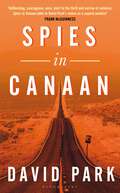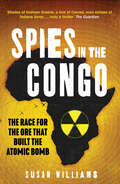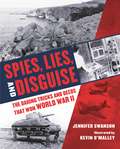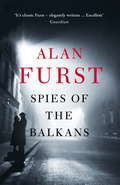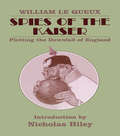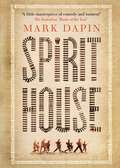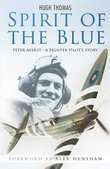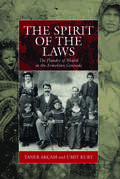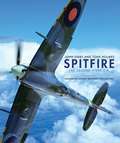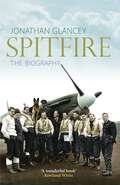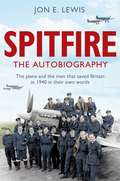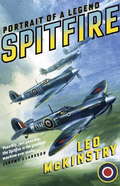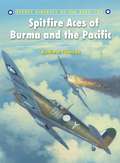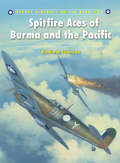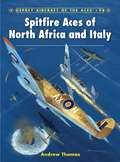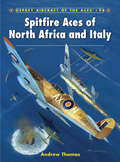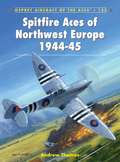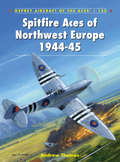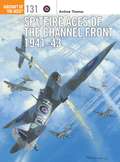- Table View
- List View
Spies in Canaan
by David ParkA bold and unsettling parable about guilt, atonement and redemption from the winner of the Kerry Group Irish Novel of the Year Award'It is seldom that one can say a book is perfect, but this is as close as I've seen in a very long time' SUNDAY INDEPENDENT'A bold and unsettling parable about guilt, atonement and redemption' IRISH TIMESMichael has travelled a long way from his boyhood under the endless skies of the Midwest. His retirement is peaceful, if solitary. But one day there is a visitation: a mysterious car on the seafront, and a package delivered. From its contents, Michael understands that he has been commissioned to undertake a final journey. As Michael makes his way deep into a distant desert – a strange and liminal landscape that lies between hell and redemption – he undertakes another journey, into long-suppressed memories: of Vietnam and the dying days of war, and to face a final accounting for what was done. Taut, atmospheric and moving, Spies in Canaan is a powerful elegy to the pain of love, the guilt of old age, and the grace of atonement.'Another compact marvel … This is a meditative novel that, while investing heavily in a patient build-up of atmosphere, never forgets the need to put a foot on the gas' DAILY MAIL'David Park's novels are always elegantly written' INDEPENDENT'Unflinching, courageous, wise, alert to the thrill and sorrow of violence ... Adds to David Park's status as a superb novelist' FRANK MCGUINNESS
Spies, Lies, and Disguise: The Daring Tricks and Deeds That Won World War II
by Jennifer SwansonIn the late 1930s, times were desperate. The world found itself at war again, less than twenty years after the first World War had ended. No one could quite believe it. And no one wanted it. The leaders of every country involved were left with no choice. They had to try to end the war as fast as possible, using whatever means they could. That meant coming up with secret operations meant to deceive, deflect, and confuse their enemies. Poison the cattle that the Germans eat? Deliberately float a corpse dressed up as a spy across the water to have it wash up on Germany's shore? Create a unit of top secret commandos with a license to kill? These were all real tactics attempted with the ultimate goal of defeating Hitler. In this off-center look at history, readers will be captivated by the classified and covert efforts made by each side as they tried to gain the upper hand and win the war. Restricted access is lifted to give the reader a peek into the top secret operations of the daring men and women who fought the war under a cloak of secrecy.
Spies of the Balkans: A Novel
by Alan FurstSalonika, 1940. To the bustle of tavernas and the smell of hashish, a secret war is taking shape. In the backrooms of barbers, envelopes change hands, and in the Club de Salonique the air is thick with whispers.
Spies of the Kaiser: Plotting the Downfall of England (Classics Of Espionage Ser.)
by William Le QueuxLe Queux was the first and most prolific of all British spy writers, but Spies of the Kaiser was not just another tale of scheming foreigners and plucky British heroes, for this paranoid tale of German secret agents plotting the invasion of Britain played a major part in the formation of MI5, Britain's counter-espionage organisation. In his introduction, intelligence historian Nicholas Hiley explains how Le Queux's powerful blend of fact and fiction inspired a whole generation of British secret service officers, and led MI5 in a nation-wide hunt for a non-existent enemy.
Spies of the Kaiser: Plotting the Downfall of England
by William Le QueuxLe Queux was the first and most prolific of all British spy writers, but Spies of the Kaiser was not just another tale of scheming foreigners and plucky British heroes, for this paranoid tale of German secret agents plotting the invasion of Britain played a major part in the formation of MI5, Britain's counter-espionage organisation. In his introduction, intelligence historian Nicholas Hiley explains how Le Queux's powerful blend of fact and fiction inspired a whole generation of British secret service officers, and led MI5 in a nation-wide hunt for a non-existent enemy.
Spirit House
by Mark DapinSHORTLISTED FOR THE 2014 ONDAATJE PRIZELONGLISTED FOR THE MILES FRANKLIN AWARD SHORTLISTED FOR THE AGE BOOK OF THE YEAR AWARDDavid is thirteen and confused. His mum has left with her lover and dumped David on his grandparents. David's grandfather, Jimmy, is seventy. He spends his days at the social club grumbling with his three best friends, all of them Jewish-Australian survivors of the enforced labour camps of the WWII Thai-Burma Railroad. But behind their playful backbiting and irresistible wit, Jimmy and his friends are haunted by the ghosts of long-dead comrades, and the only person Jimmy can confide in is a thirteen-year-old from a different world...
Spirit of the Blue: Peter Ayerst - A Fighter Pilot's Story
by Hugh ThomasPeter joined the R.A.F. in 1938 on a short-service commission and was despatched to France when war broke out. After serving with legendary fighter ace Douglas Bader, Peter was posted to North Africa in 1942, where he was forced to crash-land his Hurricane in a minefield. He flew Spitfires on intruder sorties over France before and during D-Day, on bomber escort duty against V-weapons sites and in support of mass daylight raids deep into Germany. Awarded the D.F.C. in December 1944, he also flew as fighter escort to King George VI's Dakota. By the war's end, Peter had flown every mark of Spitfire and Hurricane in the R.A.F.'s inventory.
The Spirit of the Laws: The Plunder of Wealth in the Armenian Genocide (War and Genocide #21)
by Taner Akçam Umit KurtPertinent to contemporary demands for reparations from Turkey is the relationship between law and property in connection with the Armenian Genocide. This book examines the confiscation of Armenian properties during the genocide and subsequent attempts to retain seized Armenian wealth. Through the close analysis of laws and treaties, it reveals that decrees issued during the genocide constitute central pillars of the Turkish system of property rights, retaining their legal validity, and although Turkey has acceded through international agreements to return Armenian properties, it continues to refuse to do so. The book demonstrates that genocides do not depend on the abolition of the legal system and elimination of rights, but that, on the contrary, the perpetrators of genocide manipulate the legal system to facilitate their plans.
Spitfire: The Legend Lives On (General Aviation Ser.)
by John Dibbs Tony HolmesThe Spitfire turns 80 on 5 March 2016, and the passion for the RAF's best-loved fighter is running at an all-time high. There are more than 50 Spitfires flying in the world today, and John Dibbs has shot virtually all of them 'on the wing' in his breathtaking style.This eye-catching book combines a unique collection of stunning photos with poignant first-hand accounts of flying the aeroplane in combat, from some of the most famous aces to ever pilot the Spitfire, and from some of the pilots forgotten by history. Chronicling the history of the most iconic of British aircraft this is a 'must have' purchase for aviation enthusiasts.
Spitfire: The Legend Lives On
by John Dibbs Tony HolmesThe Spitfire turns 80 on 5 March 2016, and the passion for the RAF's best-loved fighter is running at an all-time high. There are more than 50 Spitfires flying in the world today, and John Dibbs has shot virtually all of them 'on the wing' in his breathtaking style.This eye-catching book combines a unique collection of stunning photos with poignant first-hand accounts of flying the aeroplane in combat, from some of the most famous aces to ever pilot the Spitfire, and from some of the pilots forgotten by history. Chronicling the history of the most iconic of British aircraft this is a 'must have' purchase for aviation enthusiasts.
Spitfire: The Biography
by Jonathan GlanceyIt is difficult to overestimate the excitement that accompanied the birth of the Spitfire. An aircraft imbued with balletic grace and extraordinary versatility, it was powered by a piston engine and a propeller, yet came tantalisingly close to breaking the sound barrier. First flown in 1936, the Spitfire soon came to symbolize Britain's defiance of Nazi Germany in the summer of 1940. Flown by pilots of many nations, it saw service as far afield as Australia and the Soviet Union. Spitfire: The Biography is a celebration of a great British invention, of the men and women who flew it and supported its development, and of the industry that manufactured both the aircraft and the Rolls-Royce engines that powered it. It is also about a boy who wished he could have been a Second World War fighter pilot and who was later able to fly the aircraft that took his father into combat.
Spitfire
by Tony HolmesThe Spitfire is an icon of World War II, becoming the darling of the British public through defending the skies during the Battle of Britain. The Spitfire's combat ability and superb handling meant it was loved by British, Commonwealth and American pilots alike, leading to a level of global public recognition which is unparalleled amongst other aircraft – everyone recognises and connects with the iconic Spitfire. Spitfire is a complete reference guide to the world's most famous fighter aircraft, exploring its history, its strengths and weaknesses and its combat performance, using exciting full colour artwork and detailed illustrations throughout to create a premium, high quality product, combined with an affordable low price point.
Spitfire (General Military Ser.)
by Tony HolmesThe Spitfire is an icon of World War II, becoming the darling of the British public through defending the skies during the Battle of Britain. The Spitfire's combat ability and superb handling meant it was loved by British, Commonwealth and American pilots alike, leading to a level of global public recognition which is unparalleled amongst other aircraft – everyone recognises and connects with the iconic Spitfire. Spitfire is a complete reference guide to the world's most famous fighter aircraft, exploring its history, its strengths and weaknesses and its combat performance, using exciting full colour artwork and detailed illustrations throughout to create a premium, high quality product, combined with an affordable low price point.
Spitfire: The Autobiography
by Jon E. LewisA celebration of the machine and the men who took to the skies in defence of Britain. It is also the dramatic illustration of a little understood truth: the Spitfire did more than win the Battle of Britain - it won the war. It was not Stalingrad which turned the corner of the war against Hitler, it was the Spitfire in the summer of 1940 when RAF Fighter Command destroyed the myth of Nazi invincibility.Praise for his previous books:London: The Autobiography:'Fascinating ... brings the story of London to life' Good Book guideThe English Soldier: The Autobiography: 'A triumph' Saul David, author of Victoria's Army'Harrowing, funny and often unbelievable book.' Daily Express'[A] compelling tommy's eye view of war from Agincourt to Iraq' Daily Telegraph
Spitfire: Portrait of a Legend
by Leo McKinstryIn June 1940, the German Army had brought the rest of Europe to its knees. 'Hitler knows that he will have to break us in this island or lose the war. If we can stand up to him, all Europe may be free and the life of the world will move forward into broad, sunlit uplands,' said Churchill. The future of Europe depended on Britain. A self-confident Herman Goring thought that it would be only a matter of weeks before his planes had forced Britain to surrender. The courage, resourcefulness and brilliant organisation of the RAF were to prove him wrong. By late September 1940, the RAF had proved invincible, thanks to the Vickers Supermarine Spitfire. It exceeded anything that any other air force possessed. RJ Mitchell, a shy and almost painfully modest engineer, was the genius behind the Spitfire. On the 5th March 1936, following its successful maiden flight, a legend was born. Prize-winning historian Leo McKinstry's vivid history of the Spitfire brings together a rich cast of characters and first hand testimonies. It is a tale full of drama and heroism, of glory and tragedy, with the main protagonist the remarkable plane that played a crucial role in saving Britain.
Spitfire Aces of Burma and the Pacific (Aircraft of the Aces #87)
by Chris Davey Andrew ThomasThe arrival of the Spitfire in Burma came at a crucial time as the RAF struggled against the Japanese to support the Chindit operation on the ground. Proving a huge boost to morale, the Spitfire played a large part in defeating the enemy, and covering the subsequent Allied advance through Burma, protecting the ground troops and providing vital supplies. Covering this little documented aerial war, this book tells the stories of the 54 aces who flew against the Japanese, and also those who fought in India and Australia. Full-colour artwork reveals the markings and paint schemes of this most-famous of British planes, whilst first-hand accounts and archive photographs bring the aerial battles of Burma, India and Australia to life.
Spitfire Aces of Burma and the Pacific (Aircraft of the Aces #87)
by Andrew Thomas Mr Chris DaveyThe arrival of the Spitfire in Burma came at a crucial time as the RAF struggled against the Japanese to support the Chindit operation on the ground. Proving a huge boost to morale, the Spitfire played a large part in defeating the enemy, and covering the subsequent Allied advance through Burma, protecting the ground troops and providing vital supplies. Covering this little documented aerial war, this book tells the stories of the 54 aces who flew against the Japanese, and also those who fought in India and Australia. Full-colour artwork reveals the markings and paint schemes of this most-famous of British planes, whilst first-hand accounts and archive photographs bring the aerial battles of Burma, India and Australia to life.
Spitfire Aces of North Africa and Italy (Aircraft of the Aces)
by Chris Davey Andrew ThomasAlthough most famous for their role in the Battle of Britain, many Spitfire squadrons also served in the Mediterranean theatre, aiding the Allied victories in North Africa and later in the invasion of Italy. Numerous pilots, both Royal Air Force and South African Spitfire squadrons, made ace during these engagements. This book tells their story.
Spitfire Aces of North Africa and Italy (Aircraft of the Aces)
by Andrew Thomas Mr Chris DaveyAlthough most famous for their role in the Battle of Britain, many Spitfire squadrons also served in the Mediterranean theatre, aiding the Allied victories in North Africa and later in the invasion of Italy. Numerous pilots, both Royal Air Force and South African Spitfire squadrons, made ace during these engagements. This book tells their story.
Spitfire Aces of Northwest Europe 1944-45 (Aircraft of the Aces)
by Andrew Thomas Chris ThomasThis book traces the achievements of the pilots flying the iconic Spitfire in Northwest Europe, and examines how the steady technological improvements that were made throughout the Spitfire's service life improved its capabilities in the air. Based at airfields throughout southern England, Merlin engine Spitfires provided the bulk of the air cover for the D-Day landings and it was an RCAF Spitfire which claimed the first ever ME 262 jet kill. 36 colour profiles covering a broad spectrum of nationalities, units, pilots, theatres and markings complement thorough research throughout this comprehensive account of these crucial fighter aircraft.
Spitfire Aces of Northwest Europe 1944-45 (Aircraft of the Aces #122)
by Andrew Thomas Chris ThomasThis book traces the achievements of the pilots flying the iconic Spitfire in Northwest Europe, and examines how the steady technological improvements that were made throughout the Spitfire's service life improved its capabilities in the air. Based at airfields throughout southern England, Merlin engine Spitfires provided the bulk of the air cover for the D-Day landings and it was an RCAF Spitfire which claimed the first ever ME 262 jet kill. 36 colour profiles covering a broad spectrum of nationalities, units, pilots, theatres and markings complement thorough research throughout this comprehensive account of these crucial fighter aircraft.
Spitfire Aces of the Channel Front 1941-43 (Aircraft of the Aces #131)
by Andrew Thomas Mark Postlethwaite Chris Thomas80 years after the Spitfire was first developed it remains an icon of military aviation. Though many associate its victory during the Battle of Britain as the high point in the history of the Spitfire, the years following were of equal importance. Having weathered the initial storm, at the start of 1941 Fighter Command took the fight to the Germans with offensive missions over the Channel.This book reveals how first using the Spitfire I and II, and then following the introduction of the Bf 109 the cannon-armed Spitfire V, RAF squadrons embarked on a range of missions which included one of the most important air battles of the war, over Dieppe on 19 August 1942. Alongside British pilots were squadrons manned by exiled Europeans and pilots from the RAAF, RCAF and RNZAF. In just three years over 100 of these pilots were to rack up ace status in the Spitfire.
Spitfire Aces of the Channel Front 1941-43 (Aircraft of the Aces #131)
by Andrew Thomas Chris Thomas Mr Mark Postlethwaite80 years after the Spitfire was first developed it remains an icon of military aviation. Though many associate its victory during the Battle of Britain as the high point in the history of the Spitfire, the years following were of equal importance. Having weathered the initial storm, at the start of 1941 Fighter Command took the fight to the Germans with offensive missions over the Channel.This book reveals how first using the Spitfire I and II, and then following the introduction of the Bf 109 the cannon-armed Spitfire V, RAF squadrons embarked on a range of missions which included one of the most important air battles of the war, over Dieppe on 19 August 1942. Alongside British pilots were squadrons manned by exiled Europeans and pilots from the RAAF, RCAF and RNZAF. In just three years over 100 of these pilots were to rack up ace status in the Spitfire.
